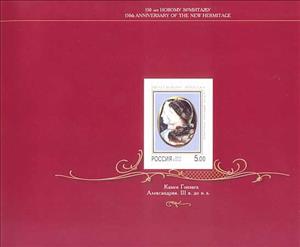Booklet Pane: Gonzaga Cameo (Aleksandriya, 3rd cent. BC) (Russia 2002)
Gonzaga Cameo (Aleksandriya, 3rd cent. BC) (Russia 2002)
15 February (Russia ) within release 150th Anniversary of New Hermitage Museum, St. Petersburg goes into circulation Booklet Pane Gonzaga Cameo (Aleksandriya, 3rd cent. BC) face value 5 Russian ruble
| Booklet Pane Gonzaga Cameo (Aleksandriya, 3rd cent. BC) in catalogues | |
|---|---|
| Michel: | Mi: RU HB17 |
Booklet Pane is horizontal format.
Text in Russian and English.Also in the issue 150th Anniversary of New Hermitage Museum, St. Petersburg:
- Booklet Pane - 150th Anniversary of New Hermitage Museum, St. Petersburg face value 15;
- Booklet Pane - Courtesan, Hendrik Goltzius (1606) face value 2.50;
- Booklet Pane - Ecco Homo, Peter Paul Rubens (c.1612) face value 2.50;
- Booklet Pane - Gonzaga Cameo (Aleksandriya, 3rd cent. BC) face value 5;
- Booklet Pane - Master Filippo Negroli, Burguignot Helmet (1530's) face value 5;
Booklet Pane Gonzaga Cameo (Aleksandriya, 3rd cent. BC) it reflects the thematic directions:
An anniversary is the date on which an event took place or an institution was founded in a previous year, and may also refer to the commemoration or celebration of that event. For example, the first event is the initial occurrence or, if planned, the inaugural of the event. One year later would be the first anniversary of that event. The word was first used for Catholic feasts to commemorate saints. Most countries celebrate national anniversaries, typically called national days. These could be the date of independence of the nation or the adoption of a new constitution or form of government. The important dates in a sitting monarch's reign may also be commemorated, an event often referred to as a "Jubilee".
Art is a diverse range of human activities in creating visual, auditory or performing artifacts (artworks), expressing the author's imaginative or technical skill, intended to be appreciated for their beauty or emotional power. In their most general form these activities include the production of works of art, the criticism of art, the study of the history of art, and the aesthetic dissemination of art. The oldest documented forms of art are visual arts, which include creation of images or objects in fields including painting, sculpture, printmaking, photography, and other visual media. Architecture is often included as one of the visual arts; however, like the decorative arts, or advertising, it involves the creation of objects where the practical considerations of use are essential—in a way that they usually are not in a painting, for example. Music, theatre, film, dance, and other performing arts, as well as literature and other media such as interactive media, are included in a broader definition of art or the arts. Until the 17th century, art referred to any skill or mastery and was not differentiated from crafts or sciences. In modern usage after the 17th century, where aesthetic considerations are paramount, the fine arts are separated and distinguished from acquired skills in general, such as the decorative or applied arts.
A museum (/mjuːˈziːəm/ mew-ZEE-əm) is an institution dedicated to displaying and/or preserving culturally or scientifically significant objects. Many museums have exhibitions of these objects on public display, and some have private collections that are used by researchers and specialists. Compared to a library, a museum hosts a much wider range of objects and usually focus around a specific theme such as the arts, science, natural history, local history, and other topics. Public museums that host exhibitions and interactive demonstrations are often considered to be tourist attractions, and many museums attract large numbers of visitors from outside their host country, with the most visited museums in the world regularly attracting millions of visitors annually.



